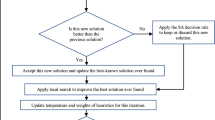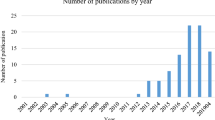Abstract
In this research, a mixed-integer nonlinear programming model is formulated to design cellular manufacturing systems (CMSs) in multiple plants in a dynamic condition. The proposed mathematical model integrates significant manufacturing characteristics in designing CMSs along with the main strategies of production planning (PP) and location–allocation (LA) problems. In addition, there are some novel characteristics that make the designed model remarkable regarding the literature including: (1) multi-plant location; (2) allocation of plants capacity to fulfill multiple markets demand; and (3) the integration of dynamic cell formation, PP and LA decisions. The objective function terms are to optimize the sale revenue and total costs of machine operating, machine overhead, inter-cell material handling, inventory holding, outsourcing, machine installation/uninstallation, products transportation, dispersing machines, establishing plants, and forming cells. A sample test problem is solved by CPLEX solver to show the achievement obtained by the characteristics incorporated into the model. Since the proposed model is NP-hard, two meta-heuristics algorithms as grey wolf optimization and genetic algorithm are developed. To verify the computational effectiveness of the employed meta-heuristics in comparison with that of CPLEX solver, its performance is tested using a number of test problems.








Similar content being viewed by others
References
Aalaei A, Davoudpour H (2016) Revised multi-choice goal programming for incorporated dynamic virtual cellular manufacturing into supply chain management: a case study. Eng Appl Artif Intell 47:3–15
Aghajani A, Didehbani SA, Kazemi M, Javadian N (2014) A dynamic non-linear mixed integer-programming model for the CMS design with production planning. Int J Ind Syst Eng 16(1):70–87
Ahkioon S, Bulgak A-A, Bektas T (2009) Integrated cellular manufacturing systems design with production planning and dynamic system reconfiguration. Eur J Oper Res 192:414–428
Allahbakhsh M, Arbabi S, Galavii M, Daniel F, Benatallah B (2019) Crowdsourcing planar facility location allocation problems. Computing 101(3):237–261
Aramoon Bajestani M, Rabbani M, Rahimi-Vahed AR, Baharian Khoshkhou G (2009) A multi-objective scatter search for a dynamic cell formation problem. Comput Oper Res 36:777–794
Arkat J, Ghahve H (2014) Scheduling of virtual manufacturing cells with outsourcing allowed. Int J Comput Integr Manuf 27(12):1079–1089
Arora P, Haleem A, Kumar H, Khan SA (2020) Recent development in virtual cellular manufacturing system recent advances in mechanical engineering. Springer, Berlin, pp 1–7
Azadeh A, Pashapour S, Abdolhossein Zadeh S (2016) Designing a cellular manufacturing system considering decision style, skill and job security by NSGA-II and response surface methodology. Int J Prod Res 54(22):6825–6847
Bayram H, Şahin R (2016) A comprehensive mathematical model for dynamic cellular manufacturing system design and Linear Programming embedded hybrid solution techniques. Comput Ind Eng 91:10–29
Chahal V, Narwal M (2019) A theoretical analysis for prioritization of lean strategies: a survey of indian manufacturing industries advances in industrial and production engineering. Springer, Berlin, pp 365–373
Deep K, Singh PK (2015) Design of robust cellular manufacturing system for dynamic part population considering multiple processing routes using genetic algorithm. J Manuf Syst 35:155–163
Defersha FM, Chen M (2006) A comprehensive mathematical model for the design of cellular manufacturing systems. Int J Prod Econ 103:767–783
Defersha FM, Chen M (2008a) A linear programming embedded genetic algorithm for an integrated cell formation and lot sizing considering product quality. Eur J Oper Res 187(1):46–69
Defersha FM, Chen M (2008b) A parallel multiple Markov chain simulated annealing for multi period manufacturing cell formation. Int J Adv Manuf Technol 37:140–156
Delgoshaei A, Ariffin MKAM, Leman Z, Baharudin BHTB, Gomes C (2016a) Review of evolution of cellular manufacturing system’s approaches: material transferring models. Int J Precis Eng Manuf 17(1):131–149
Delgoshaei A, Ali A, Ariffin MKA, Gomes C (2016b) A multi-period scheduling of dynamic cellular manufacturing systems in the presence of cost uncertainty. Comput Ind Eng 100:110–132
Deljoo V, Mirzapour Al-e-hashem SMJ, Deljoo F, Aryanezhad MB (2010) Using genetic algorithm to solve dynamic cell formation problem. Appl Math Model 34(4):1078–1092
Drolet J, Marcoux Y, Abdulnour G (2008) Simulation-based performance comparison between dynamic cells, classical cells and job shops: a case study. Int J Prod Res 46(2):509–536
Fard AMF, Hajaghaei-Keshteli M (2018) A tri-level location–allocation model for forward/reverse supply chain. Appl Soft Comput 62:328–346
Farughi H, Dolatabadiaa M, Moradi V, Karbasi V, Mostafayi S (2017) Minimizing the number of tool switches in flexible manufacturing cells subject to tools reliability using genetic algorithm. J Ind Syst Eng 10(special issue on Quality Control and Reliability):17–33
Farughi H, Mostafayi S, Afrasiabi A (2019) Bi-objective robust optimization model for configuring cellular manufacturing system with variable machine reliability and parts demand: a real case study. J Ind Eng Manag 6(2):120–146
Gen M, Cheng R (1997) Genetic algorithms and engineering design. Wiley, Cambridge
Ghezavati VR (2015) Designing integrated cellular manufacturing systems with tactical decisions. J Chin Inst Eng 38(3):332–341
Ghezavati V, Sadjadi S, Dehghan Nayeri M (2011) Integrating strategic and tactical decisions to robust designing of cellular manufacturing under uncertainty: fixed suppliers in supply chain. Int J Comput Intell Syst 4(5):837–854
Ghodsi R, Mostafayi S, Mansouri Z, Bakhtiari M (2015) Designing a bi-objective integrating mathematical model for dynamic sustainable cellular manufacturing systems considering production planning. J Appl Mech Eng 4:184
Ghotboddini MM, Rabbani M, Rahimian H (2011) A comprehensive dynamic cell formation design: Benders’ decomposition approach. Expert Syst Appl 38(3):2478–2488
Holland JH (1975) Adaptation in natural and artificial system. Univ. of Michigan Press, Ann Arbor
Hosseinabad ER, Zaman MAU (2020) A brief review on cellular manufacturing and group technology. Res J Manag Rev 5(1):1–20
Imran M, Kang C, Lee YH, Jahanzaib M, Aziz H (2017) Cell formation in a cellular manufacturing system using simulation integrated hybrid genetic algorithm. Comput Ind Eng 105:123–135
Kia R, Baboli A, Javadian N, Tavakkoli-Moghaddam R, Kazemi M, Khorrami J (2012) Solving group layout design model of a dynamic cellular manufacturing system with alternative process routing, lot splitting and flexible reconfiguration by simulated annealing. Comput Oper Res 39:2642–2658
Kia R, Javadian N, Tavakkoli-Moghaddam R (2014a) A simulated annealing algorithm to determine a group layout and production plan in a dynamic cellular manufacturing system. J Optim Ind Eng 14:37–52
Kia R, Khaksar-Haghani F, Javadian N, Tavakkoli-Moghaddam R (2014b) Solving a multi-floor layout design model of a dynamic cellular manufacturing system by an efficient genetic algorithm. J Manuf Syst 33(1):218–232
Kia R, Shirazi H, Javadian N, Tavakkoli-Moghaddam R (2015) Designing group layout of unequal-area facilities in a dynamic cellular manufacturing system with variability in number and shape of cells. Int J Prod Res 53(11):3390–3418
Li J, Wang A, Tang C (2014) Production planning in virtual cell of reconfiguration manufacturing system using genetic algorithm. Int J Adv Manuf Technol 74(1–4):47–64
Liu C, Wang J, Leung JYT (2016) Worker assignment and production planning with learning and forgetting in manufacturing cells by hybrid bacteria foraging algorithm. Comput Ind Eng 96:162–179
Liu C, Wang J, Leung JYT (2018) Integrated bacteria foraging algorithm for cellular manufacturing in supply chain considering facility transfer and production planning. Appl Soft Comput 62:602–618
Lokesh K, Jain PK (2010) Dynamic cellular manufacturing systems design—a comprehensive model and HHGA. Adv Prod Eng Manag 5(3):151–162
Lokesh K, Jain PK (2012) An integrated model of dynamic cellular manufacturing and supply chain system design. Int Adv Manuf Technol 62:385–404
Man KF, Tang KS, Kwong S (1999) Genetic algorithms: concepts and design. Springer, London
Melo MT, Nickel S, Saldanha-da-Gama F (2009) Facility location and supply chain management—a review. Eur J Oper Res 196:401–412
Mirjalili S, Mirjalili SM, Lewis A (2014) Grey wolf optimizer. Adv Eng Softw 69:46–61
Molla-Alizadeh-Zavardehi S, Sadi Nezhad S, Tavakkoli-Moghaddam R, Yazdani M (2013) Solving a fuzzy fixed charge solid transportation problem by metaheuristics. Math Comput Model 57:1543–1558
Neufeld JS, Gupta JN, Buscher U (2016) A comprehensive review of flowshop group scheduling literature. Comput Oper Res 70:56–74
Nouri H (2016) Development of a comprehensive model and BFO algorithm for a dynamic cellular manufacturing system. Appl Math Model 40(2):1514–1531
Paydar MM, Saidi-Mehrabad M (2015) Revised multi-choice goal programming for integrated supply chain design and dynamic virtual cell formation with fuzzy parameters. Int J Comput Integr Manuf 28:251–265
Paydar MM, Saidi-Mehrabad M, Teimoury E (2014) A robust optimisation model for generalised cell formation problem considering machine layout and supplier selection. Int J Comput Integr Manuf 27(8):772–786
Pillai VM, Subbarao K (2008) A robust cellular manufacturing system design for dynamic part population using a genetic algorithm. Int J Prod Res 46(18):5191–5210
Rafiee K, Rabbani M, Rafiei H, Rahimi-Vahed A (2011) A new approach towards integrated cell formation and inventory lot sizing in an unreliable cellular manufacturing system. Appl Math Model 35(4):1810–1819
Rao PP, Mohanty RP (2003) Impact of cellular manufacturing on supply chain management: exploration of interrelationships between design issues. Int J Manuf Technol Manag 5(5/6):507–520
Raoofpanah H, Ghezavati V, Tavakkoli-Moghaddam R (2019) Solving a new robust green cellular manufacturing problem with environmental issues under uncertainty using Benders decomposition. Eng Optim 51(7):1229–1250
Renna P, Ambrico M (2015) Design and reconfiguration models for dynamic cellular manufacturing to handle market changes. Int J Comput Integr Manuf 28(2):170–186
Rheault M, Drolet J, Abdulnour G (1995) Physically reconfigurable virtual cells: a dynamic model for a highly dynamic environment. Comput Ind Eng 29:221–225
Safaei N, Tavakkoli-Moghaddam R (2009) Integrated multi-period cell formation and subcontracting production planning in dynamic cellular manufacturing systems. Int J Prod Econ 120:301–314
Sakhaii M, Tavakkoli-Moghaddam R, Bagheri M, Vatani B (2016) A robust optimization approach for an integrated dynamic cellular manufacturing system and production planning with unreliable machines. Appl Math Model 40(1):169–191
Schaller J (2008) Incorporating cellular manufacturing into supply chain design. Int J Prod Res 46(17):4925–4945
Shafigh F, Defersha FM, Moussa SE (2017) A linear programming embedded simulated annealing in the design of distributed layout with production planning and systems reconfiguration. Int J Adv Manuf Technol 88(1–4):1119–1140
Shiyas CR, Madhusudanan Pillai V (2014) A mathematical programming model for manufacturing cell formation to develop multiple configurations. J Manuf Syst 33(1):149–158
Wicks EM, Reasor RJ (1999) Designing cellular manufacturing systems with dynamic part populations. IIE Trans 3:11–20
Wu X, Chu CH, Wang Y, Yue D (2007a) Genetic algorithms for integrating cell formation with machine layout and scheduling. Comput Ind Eng 53:277–289
Wu X, Chu CH, Wang Y, Yan W (2007b) A genetic algorithm for cellular manufacturing design and layout. Eur J Oper Res 181:156–167
Zhu Z, Chu F, Sun L (2010) The capacitated plant location problem with customers and suppliers matching. Transp Res Part E 46:469–480
Zohrevand AM, Rafiei H, Zohrevand AH (2016) Multi-objective dynamic cell formation problem: a stochastic programming approach. Comput Ind Eng 98:323–332
Author information
Authors and Affiliations
Corresponding authors
Ethics declarations
Conflict of interest
Author Shima Shafiee-Gol declares that she has no conflict of interest. Author Reza Kia declares that he has no conflict of interest. Author Mohammad Kazemi declares that he has no conflict of interest. Author Reza Tavakkoli-Moghaddam declares that he has no conflict of interest. Author Sobhan Mostafayi declares that he has no conflict of interest.
Ethical approval
This article does not contain any studies with human participants or animals performed by any of the authors.
Additional information
Communicated by V. Loia.
Publisher's Note
Springer Nature remains neutral with regard to jurisdictional claims in published maps and institutional affiliations.
Electronic supplementary material
Below is the link to the electronic supplementary material.
Rights and permissions
About this article
Cite this article
Shafiee-Gol, S., Kia, R., Kazemi, M. et al. A mathematical model to design dynamic cellular manufacturing systems in multiple plants with production planning and location–allocation decisions. Soft Comput 25, 3931–3954 (2021). https://doi.org/10.1007/s00500-020-05417-2
Published:
Issue Date:
DOI: https://doi.org/10.1007/s00500-020-05417-2




